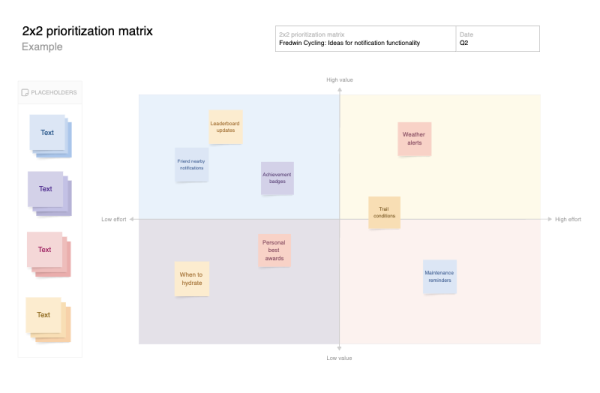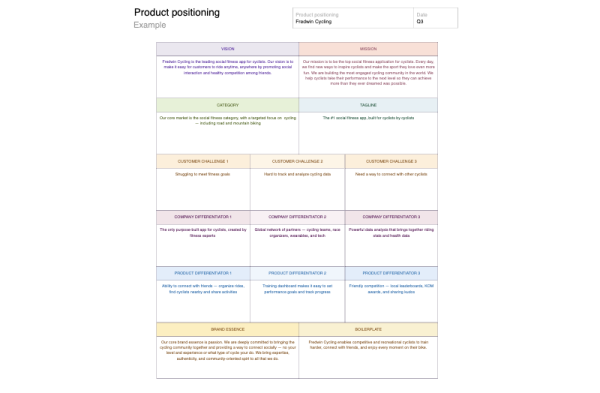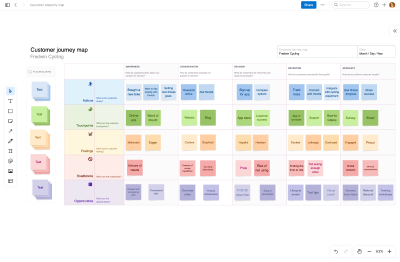Why product teams need whiteboard software
Last updated: May 2024
Whiteboard software is more popular than ever. As virtual collaboration has become the new norm for remote and hybrid work environments, whiteboard software offers a number of benefits that make it an excellent replacement for the traditional boards and markers you would find in office conference rooms.
Seems like a no-brainer, right? Whiteboard software is an obvious choice for the same reasons you would choose instant messaging over a fax machine these days. But beyond modern convenience, whiteboard software can boost productivity and collaboration. It can even enhance the specific work you do (if you choose the right kind of whiteboard tool).
Brainstorm, prioritize, collaborate — try whiteboards in Aha! software.
Having a visual space for innovation matters, and especially for product development teams that puzzle over product requirements, create wireframes and mockups, or collaborate on user story mapping. So it is important to choose your tool with intention.
This guide covers the different types of whiteboarding software, use cases for product teams, and what to look for in a tool. Let's dive in:
What is whiteboard software?
Whiteboard software, or a virtual whiteboard, is a digital tool for capturing ideas, creating diagrams and sketches, and collaborating visually with others. Whiteboard software is especially helpful for facilitating both real-time and asynchronous collaboration on remote teams. Everyone can view the same whiteboards at their convenience in their own time zones without worrying about the contents getting erased. Depending on the tool, you might start with a blank canvas or a whiteboard template.
Types of whiteboard software
Many whiteboarding tools offer the same core features, such as templates and live collaboration. But you can generally separate them into two categories: all-purpose and purpose-built.
All-purpose whiteboard tools are made for anyone to use. Meant to replace physical in-office whiteboards, many include templates for a wide mix of uses — everything from team icebreakers to IT work order processes and sales presentations. Some support videoconferencing as well. This broad range of uses makes all-purpose whiteboards appealing to many organizations as a one-size-fits-all solution.
Purpose-built whiteboard software is thoughtfully designed for a particular discipline. It includes features tailored to specific needs and ideally integrates with tools you already use to get work done. For example, whiteboard tools exist for teachers that help with lesson planning and connect with learning management systems.
This was our thinking when we developed Aha! Whiteboards. As fellow product builders, we wanted a virtual whiteboard made for our daily work. Our software includes functionality and templates geared toward product development tasks, including feature prioritization and PI planning. Aha! Whiteboards also integrates seamlessly with Aha! Roadmaps so you can connect ideas to actionable roadmap items within the same software environment.
If you are considering whiteboarding software for your product team, think about how you really want to use it. You will most likely need it for more complex work than a generic whiteboard tool can support. Instead, choose a virtual whiteboard designed for product development that will support everything you do — from ideation to roadmapping.
Related:
How product development teams use whiteboard software
It can be tough to break away from thinking of whiteboards as simple brainstorming tools. But there is a lot hiding under that blank canvas. In addition to creative ideation, product teams can use whiteboard software as a visual space for collaborating on strategy, design, product planning, and more.
It takes a couple of things to do this successfully. You need to choose a tool that is equipped for these use cases. You also need to be intentional about when and how you use your whiteboard software — making a point to incorporate it into your daily work and weekly meetings.
When you take this approach, you might be surprised by the ways you can rely on whiteboarding for various tasks. Here are some specific examples of how purpose-built whiteboard software can support different aspects of product development:
Area of product development | Use cases for whiteboard software |
Setting product strategy |
|
Product ideation |
|
UX and product design |
|
Feature prioritization |
|
Planning development work |
|
Stakeholder updates |
|

See the full collection of templates in the Aha! template library.
Related:
What to look for in whiteboard software
What makes an exceptional virtual whiteboard? A generic tool might offer the most versatility. But something intended for one-size-fits-all use will not always give you everything you need.
If you work in an area that requires a tightly integrated tech stack, agile workflows, and rapid innovation — like product development — purpose-built whiteboarding software is the way to go. (And we think you will really like it.)
Aha! Whiteboards is designed for product builders, and we are rapidly adding even more functionality for you. Get started for free and then let us know how we can make our whiteboarding tool the best it can be for your team. Start exploring features, including:
A comprehensive set of drawing tools (including text boxes, shapes, sticky notes, connectors, and tables)
Expert guided templates for product development work
Collaboration tools, such as commenting and voting sessions
Robust wireframing capabilities
A built-in presentation mode
Unlimited guest access
Integrations with Aha! Roadmaps, Jira, and more


